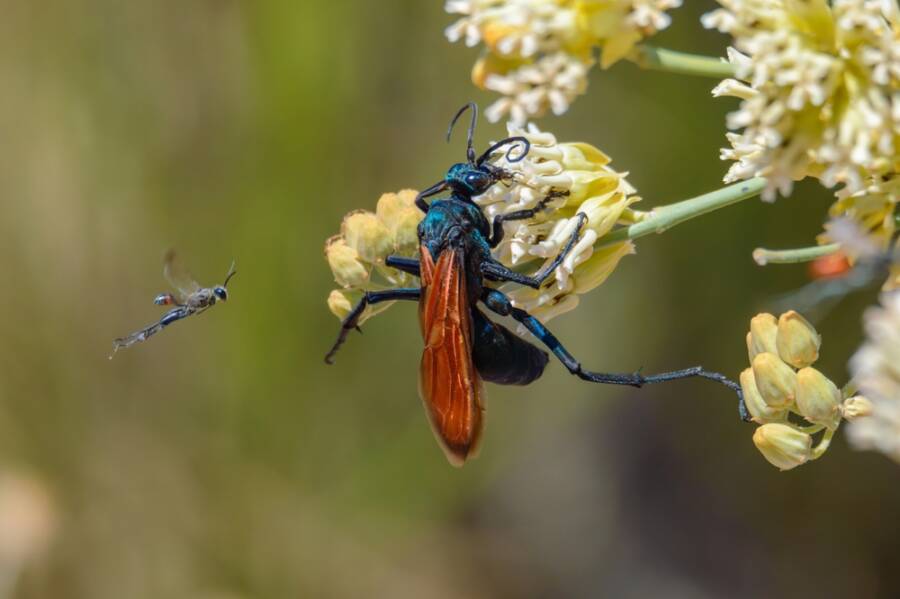Planning a trip? These are the most dangerous animals in California to watch out for!
From idyllic Emerald Bay to the picturesque Yosemite National Park, California’s varied landscapes are home to an astounding variety of wildlife that attracts thousands of tourists every season. While some can be extremely dangerous to people, the majority provide a pleasant experience.
Things change a bit when people move into more rural areas and the likelihood of harmful human-animal interactions becomes greater than usual. There are certain animals to be cautious of when going into the great outdoors, even though most animals would rather be left alone.
From poisonous snakes like the northern Pacific rattlesnake to marine life like stingrays, it’s important to know the most dangerous animals in California and understand the possible risks in the wild, and of course how to prevent any confrontations with them.

Widow spider
Yikes, spiders! Oh well, I bet you expect that the widow spider would be among the most dangerous animals in California, but how many things do you know about it? Let’s see. The notorious black widow and the brown widow are the two kinds of widow spiders found in California. The majority of the state is home to black widows, but they usually love isolated, dark places like drains, pipes, and sheds.
Their bodies are black, and females, which are around 1.5 inches (3.8 cm) long, have a characteristic red hourglass shape on their belly. These spiders typically only bite their prey, which is primarily insects, and are not aggressive.
They may, however, unintentionally bite defensively if threatened. Although human deaths from widow spider bites are rare, small mammals, elderly people, and young children may be at risk.
Keep an eye out for symptoms such as fever, high blood pressure, nausea, cramping in the stomach, and chest pain if you have been bitten by a widow spider. To prevent complications, get medical help as soon as possible.
Western diamondback rattlesnake
In terms of size and fatalities, the western diamondback rattlesnake is the second most dangerous animal in California and the most deadly and largest of all rattlesnakes that live in the area. These rattlesnakes, which can reach a maximum length of 5 feet (1.5 meters) and are found in grasslands and deserts across Southern California, are distinguished by a rattle on their tail and a noticeable diamond pattern along their body.
They typically only attack when threatened, but they are known for being aggressive and are unlikely to back down from a fight. Their venom and speed make them extremely dangerous.
Within 70 milliseconds, a western diamondback can strike, inflicting up to 800 milligrams of venom, which ends in tissue deterioration, irritation, and swelling.
Every year, many bites are reported, and it’s important to remember that if they’re not treated, 10–20% could lead to serious outcomes. The good news is that getting medical help quickly can really help reduce the effects of venom. Stay safe and seek help if needed!
Southern Pacific rattlesnake
Among the most dangerous animals in California is another species of rattlesnake, this time the one that lives in the Southern Pacific. It is a California native and one of the biggest rattlesnakes in the state. It has large, dark brown spots along its back and is brown or olive-brown, reaching a maximum length of 4.5 feet (1.4 meters).
The venom may result in paralysis, problems with the nervous system, blood clotting, and localized tissue damage. These rattlesnakes, which are found in arid grasslands and are frequently spotted relaxing on hiking trails, usually only attack when they feel threatened. Avoid making abrupt movements, and give the snake room to leave if you come across it.
Mountain lion
Don’t be fooled by this animal’s physical appearance, because despite looking adorable, they’re among the most dangerous in the whole state. They’re not easy to spot, mostly because they live in mountainous and forested regions, so you might not encounter them that easily.
However, it’s important to know that these magnificent creatures can grow up to 8 feet (2.44 meters) in length, including their tail, and weigh between 64 and 220 pounds (29 and 100 kg). Deer, rabbits, rodents, wild pigs, sheep, and coyotes are their main food sources. The state is home to an estimated 4,500 mountain lions, so human attacks are uncommon but frequently fatal.
Avoid running if you come across one because this will automatically make the mountain lion chase you. Instead, avoid direct eye contact, make loud noises, and enlarge yourself.
When traveling with children, please keep a close eye on them! Kids are often curious and want to explore and touch everything new, often unaware of the risks involved.

Tarantula hawk wasp
As the name implies, tarantula hawk wasps are insects that feed on tarantulas. California’s deserts, particularly those in the south, are home to them. These wasps have bright orange wings and dark blue bodies, and they are larger than typical wasps, measuring about 2.5 inches (6.4 cm) in length. Although they are usually not hostile toward people, they will sting if provoked, and the sting is extremely painful; in fact, it is considered to be among the most agonizing insect bites.
When hunting, they use this potent sting to paralyze the larger tarantulas. After that, the wasp will bury the egg it laid on the tarantula. Upon hatching, the larvae consume the paralyzed tarantula while it is still alive, gradually depleting its vital organs of energy. It is understandable why people consider these violent insects to be very unpleasant to deal with.
Are you planning to visit more of your country in the near future, and on your wishlist are there places like Florida, Georgia, Kentucky, Louisiana, and Mississippi? Besides packing your bags with appropriate outfits according to the forecast, you may also want to check out a few of the most dangerous animals that live in these areas.
Dangerous Wildlife in the Southeast: A Guide to Safe Encounters At Home and in the Wild is a great book that will help you know things beforehand to avoid danger and make your trip as smooth as possible. It’s available on Amazon for $17.21.
Stingray
Although they are not as bad as they appear, stingrays can be dangerous when exploring California’s coastal waters. Being bottom dwellers, they are difficult to identify because they hide in the sand along the bottom of shallow waters. Stingrays have a long, barbed tail with poisonous spines, and they are comparatively broad and flat.
The majority of stingray injuries result from unintentional stepping on them; these painful puncture wounds can bleed, burn, swell, and become infected. So even if there is a small chance of being attacked by a stingray, if it happens to you, seek medical care as soon as possible.
Great white shark
And we’re finally at the bottom of the list of the most dangerous animals in California. Last but not least is the great white shark, which is a predator, but interactions with human beings are usually very rare. In California, there have been about 188 white shark incidents since 1950, 16 of which have resulted in death. Still, it’s better to be safe than sorry!
Particularly in Southern California, young sharks frequently swim in shallower waters along the shore. At birth, little sharks are 4-5 feet (1.2-1.5 meters) tall. During their young stage, they grow to roughly 10 feet (3 meters), and eventually, they can reach up to 20 feet (6 meters).
You may also want to read about 13 Fascinating Tiny Animals You Have No Idea They Exist.














